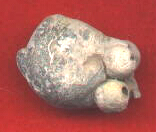Guest
Sorry- I just re-read the posts, and see this was at a mere 25yds. My mistake - so
: Question- is there a possibility that there was a double hole? Now, up here, the people who set the rules have never scored a smokeless target before, nor were they particularly good shots themselves. The reason I say that is If they had, they'd have to know that if there is a big hole, larger than calibre, they have to give any shots not visible, to going through that hole, providing it merely isn't two, side by side, positively only two shots by being plugged. By the rules, tested many times and always found for the shooter - a 1" or 3/4" dia hole for a 10 shot event(smokeless), held that all ten shots went through that hole, not just the ones visible around the outside perifery of that hole.
: I found this out at the first registered B.C.Summer Games match I attended. Up until that time, I was merely a BP hunter, BP sport shooter & I also shot position competition with smokeless & was an official of the Shooting Federation of Canada.
: My whole reaoning for bringing this up, is that perhaps, being schooled by this outside-count only, may have trained someone to think they had missed, when in all actuality, they hadn't. This also happens up here.
: SO - Did the missing ball, possibly go through another hole? A hole even slightly bigger than cal. would very well be the recipient of that ball - otherwise, a hang-fire flinch is the only way I can see missing something that big - at only 25yds., or a conbination of conditions noted. Little things can add up to a biggee. Sorry? or Good shooting, as the case might be!
: Now - at 50 or 75yds, with a smoothbore, perhaps this air void theory could have been a contributing factor.
Daryl
: Question- is there a possibility that there was a double hole? Now, up here, the people who set the rules have never scored a smokeless target before, nor were they particularly good shots themselves. The reason I say that is If they had, they'd have to know that if there is a big hole, larger than calibre, they have to give any shots not visible, to going through that hole, providing it merely isn't two, side by side, positively only two shots by being plugged. By the rules, tested many times and always found for the shooter - a 1" or 3/4" dia hole for a 10 shot event(smokeless), held that all ten shots went through that hole, not just the ones visible around the outside perifery of that hole.
: I found this out at the first registered B.C.Summer Games match I attended. Up until that time, I was merely a BP hunter, BP sport shooter & I also shot position competition with smokeless & was an official of the Shooting Federation of Canada.
: My whole reaoning for bringing this up, is that perhaps, being schooled by this outside-count only, may have trained someone to think they had missed, when in all actuality, they hadn't. This also happens up here.
: SO - Did the missing ball, possibly go through another hole? A hole even slightly bigger than cal. would very well be the recipient of that ball - otherwise, a hang-fire flinch is the only way I can see missing something that big - at only 25yds., or a conbination of conditions noted. Little things can add up to a biggee. Sorry? or Good shooting, as the case might be!
: Now - at 50 or 75yds, with a smoothbore, perhaps this air void theory could have been a contributing factor.
Daryl








